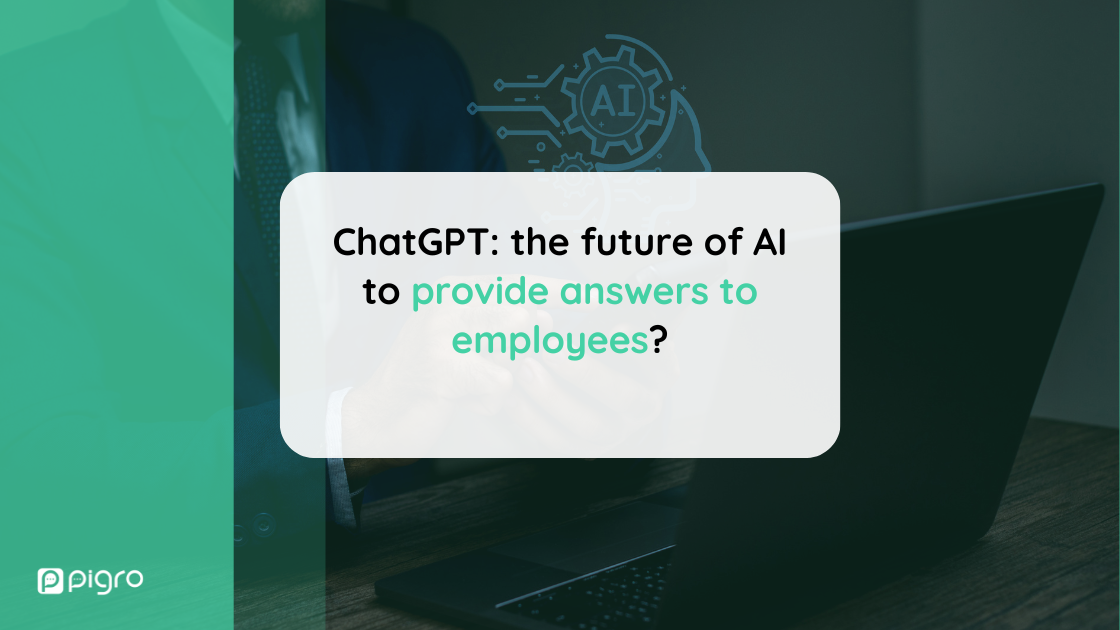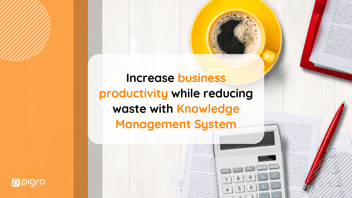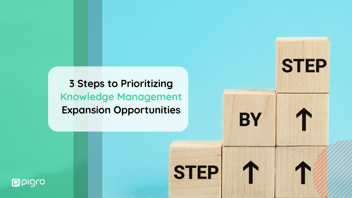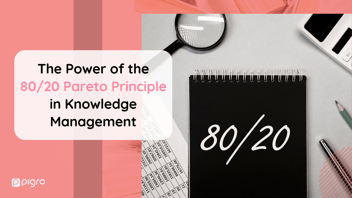Chat GPT is an Artificial Intelligence capable of writing and generating content of all types and on any subject.
Nowadays it is talked about everywhere and this technology, which has been booming online since last November and within the first week of its launch has conquered one million users, has been described by many as revolutionary.
Yes, even we at Pigro have tried it, to test it in different fields and with different requests - we confess, some of the SEO titles of this article were generated by the chatbot! - and we tried to understand what daily tasks in the company could be simplified by its use.
And above all, what advantages and disadvantages it might have in the field of knowledge management and information retrieval.
In short, we think the potential is enormous, but... are we sure it can solve all our problems?
- ChatGPT what is it and how to use it
- How ChatGPT technology works
- How GPT chatbot can speed up work in the company
- Limitations and weaknesses of chatbot GPT
- The future of AI to provide answers to users: human and artificial intelligence
ChatGPT what is it and how to use it
If you already know what chat GPT is and how it works, you can skip this part - click here!
First of all, ChatGPT stands for “Chat Generative Pre-trained Transformer” and is an AI and machine learning-based chatbot created by OpenAI, a research and development company in the field of AI, in collaboration with Microsoft.
It is currently available online on the OpenAI website and you need to register with your email address to start using it.
Being a chat, to use it you need to write a request, insert a portion of text or an input phrase in the text bar, to start interacting. In addition to providing answers on topics of any category, the GPT chat is also able to write content, create lists, solve mathematical equations, translate languages, generate code, create summaries, provide instructions.
Below, a small recap of how this chatbot can be used:
-
Answer users' questions and also be used as a Customer Service chatbot.
-
Write articles and blog posts on a large number of topics.
-
Generate scripts and dialogues such as TV show scripts, video games, etc.
-
Create product descriptions for a catalogue or e-commerce site, saving time and effort.
-
Write social media captions with hashtags.
-
Write poetry and song lyrics
How ChatGPT technology works
ChatGPT is based on a Deep-Learning model called Large Learning Model that leverages artificial intelligence and neural networks to store and learn from a large amount of data.
The chatbot was then trained on Open AI’s Instruct GPT or GPT-3.5 models, which are models where the pre-training phase has been optimised by human intervention.
In short, it suffices to know that thanks to all the training carried out on data, including manual pages and information on the Internet and programming languages, perfected with the help of human instructors, Chat GPT is able of understanding requests and provide answers, remembering previous interactions within the same conversation.
Here we asked the chatbot to explain the technology behind it:
Harnessing the Power of Pigro and ChatGPT for Seamless Knowledge Sharing in the Company
In today's fast-paced business environment, knowledge sharing is crucial for companies to stay competitive and innovative. With the advancements in AI and machine learning, tools like Pigro and ChatGPT are revolutionizing the way organizations manage and disseminate information within their workforce.
Pigro, a cutting-edge knowledge management system, provides companies with a comprehensive solution for organizing and accessing large amounts of documentation. It's intelligent algorithms and intuitive interface make it easy for employees to find the information they need quickly and accurately. By harnessing the power of Pigro, companies can streamline their knowledge-sharing processes and empower their employees to make informed decisions.
ChatGPT, on the other hand, takes knowledge sharing to a whole new level by leveraging the capabilities of AI and natural language processing. As mentioned earlier, this AI-powered chatbot developed by OpenAI and Microsoft can generate content, answer questions, and even provide instructions on a wide range of topics. By integrating ChatGPT into their workflow, companies can enhance their customer service, marketing, content creation, and HR processes.
Imagine a scenario where a salesperson needs to draft a business plan or an annual sales forecast. With the help of ChatGPT, they can simply provide the necessary data, and the chatbot will generate a comprehensive document in a matter of minutes. This not only saves time but also ensures consistency and accuracy in the generated content.
For marketers and content creators, ChatGPT can be a game-changer. It can assist in writing articles, product descriptions, social media copies, and even propose new content ideas. By collaborating with ChatGPT, marketers can boost their productivity and creativity, while also maintaining the quality and relevance of their content.
Customer care and help desk departments can also benefit from ChatGPT. The chatbot can automate the creation of FAQs and other user support content, freeing up valuable time for customer service representatives to focus on more complex issues. This not only improves customer satisfaction but also reduces costs for companies.
Lastly, HR departments can leverage ChatGPT to expedite the process of drafting company guidelines and policies. With its ability to understand requests and provide relevant answers, the chatbot can assist HR professionals in creating these documents more efficiently. This ensures that the company's policies are communicated clearly and consistently to all employees.
While Pigro and ChatGPT offer incredible benefits for seamless knowledge sharing in the company, it is important to acknowledge their limitations. As mentioned earlier, ChatGPT may not always provide the most accurate or up-to-date information, and its responses may be influenced by biases present in the training data. As such, human intervention and oversight are still necessary to ensure the quality and reliability of the content generated by these tools.
In conclusion, the power of Pigro and ChatGPT in facilitating seamless knowledge sharing in companies cannot be underestimated. By harnessing the capabilities of AI and machine learning, organizations can streamline their processes, increase productivity, and enhance decision-making. However, it is crucial to strike a balance between automation and human intervention to ensure the accuracy, relevance, and reliability of the information shared. With the continuous advancement of technology, it will be interesting to see how virtual assistants and knowledge management systems like Pigro evolve in the future to meet the ever-changing needs of businesses.
Limitations and weaknesses of chatbot GPT
It is clear now what the potential of this tool is but after testing it a little, or even just reading online, there are also some limitations that, as expected, chatGPT is proving to have.
Certainly, if you asked about very recent topics, you may have received a message in response indicating that the update of data available to the chatbot dates back to late 2021. It doesn’t know events that happened after that period.
Moreover, as explained by the developers, the AI behind ChatGPT is not immune from bias e prejudices, since it draws its answers from the base of information on which it has been trained.
Since the chatbot has been designed to be safe, harmless and avoid potentially damaging topics, it has by default intentional prejudices to prevent negative behaviour. So the answers provided may not be as neutral as you think, influenced by the "good intentions" for which it is set.
Obviously, it is still an artificial intelligence, therefore not able to make judgments, critical thinking, make decisions like the human brain and not even be creative.
And this can be a problem, as in the case of tech news website CNET, which from November until now has published around 70 article posts written by artificial intelligence, without communicating it transparently to readers.
This is according to Futurism, which identified the problem, noting a series of trivial mistakes in the content of the articles, as well as entire sentences that can be traced back to other articles previously published elsewhere, without any specific source citation. As a result, CNET first inserted correction notes in articles or notifications on the veracity of the content, then announced the suspension of the publication of AI-generated articles.
However, as some studies from Johns Hopkins University, New York University and Microsoft have argued, it should come as no surprise that there are phrases or excerpts from other content, because systems like Chat GPT that rely on LLM (Large Learning Models) exploit the vast amount of data entered for learning to generate new text, indeed "sometimes they copy substantially [...] from the training set" (source: Carola Frediani, Guerre di Rete, N.150 28 Jan 2023).
Content generated by AI needs, in fact, constant reworking to be original and not fall into plagiarism, as well as the fact that the more details are input into, the more GPT will be able to process a valid and less “mass-produced” response.
But, above all, the most criticised aspect is the accuracy and reliability of the answers. If the sources on which ChatGPT has been trained are currently not publicly available, transparency and truthfulness become a problem. In many cases some answers given by the system have proved false - not to say real fake news - presented as certain and therefore impossible to recognise if you know nothing about the subject.
Google is already taking advantage of the controversy by revealing that is developing a chatbot aimed to be a direct competitor of ChatGPT: Sparrow. Its strengths will be greater accuracy in answers and the ability to cite its sources, as well as being developed by Google, it will be able to count on frequent content updates and may be directly integrated into Google Search.
The future of AI to provide answers to users: human and artificial intelligence
GPT Chat is already so powerful and in the years to come will only perfect its operations, storing even more data and feedback. This means more simplicity in creating content, more automatically generated materials, but also more difficulty in ensuring quality and reliability.
So, at Pigro - which works with AI, we have produced chatbots, we have refined them and then fully dedicated our mission to knowledge management, providing precise and coherent answers to users, to minimize the effort of organizing and consulting large amounts of documentation - we cannot help but wonder:
So, what about virtual assistants that have been popular until now? What will be their function in the future?
Will information retrieval and knowledge management systems, like ours, still be useful to find information?
Will GPT Chat be the big competitor to beat? Will we be forced to evolve?
What does technological progress hold for us?
From these increasingly gripping and concrete doubts, a consideration sparked:
Despite the apparent ease with which chatGPT can be used to automate many tasks (such as in the basic requests of Customer Assistance, already carried out by chatbot) in order to engage in higher added value activities, the fact remains that to obtain a valid, up-to-date and reliable content, human intervention of improvement is still necessary.
Chat GPT is unable to reason, make value judgements, and provide source verification for information.
While representing a valuable ally with certainly remarkable abilities, the final step that gives validity to content must be provided to human intelligence.
So what can be our contribution?
Pigro has developed and is improving a feature to analyse content quality: Knowledge Insights measures the effectiveness of the company knowledge base and provides suggestions to increase it.
The knowledge base can be analysed, for example, in terms of content structure, or the presence of headings, paragraphs, redundant elements, broken links, etc. which affects the legibility and therefore the efficacy for the readers. Or can evaluate the repositories organization, the access permissions to folders, etc. which affects knowledge sharing and usability.
These are just some of the parameters used to understand any issues that impact the search for information in the companies. Each insight is provided with ad hoc suggestions to improve the efficiency of company documentation.
The Knowledge Insights tool from Pigro can be useful even when we have not directly produced the content, as in the case of those automatically generated by AI.
In conclusion, we believe that ChatGPT could be a disruptive technology to provide answers at an impressive speed, but in our opinion, the real potential of this tool lies in the ability to help people in the early stages of content creation, and cannot (nor should) replace human intervention.
In order not to witness in the future the flattening (also in terms of quality) of the contents in circulation are necessary, in fact, the elements of novelty and originality that only human thought can bring.
Measure the quality of your knowledge base and access the Knowledge Insights from Pigro: start now!
Fill in the form to receive an email with the next steps to connect your repository and the NDA for your documentation.



